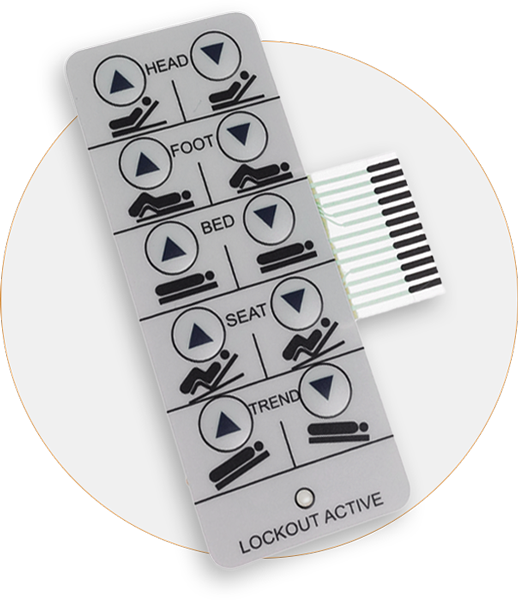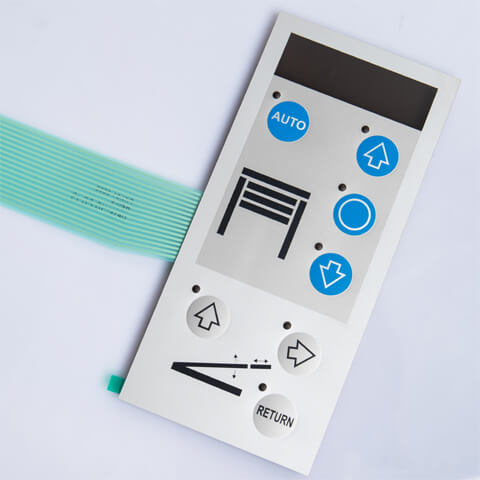The Role of Membrane Changes in Enhancing Device Functionality and Aesthetic Appeal
Membrane layer changes represent a significant development in user interface innovation, effortlessly incorporating usability with visual charm. As sectors increasingly focus on user experience, the ramifications of these attributes prolong beyond mere benefit, affecting product style and consumer satisfaction.
Recognizing Membrane Layer Switch Over Modern Technology

The graphic overlay functions as the noticeable surface area, usually printed with symbols and labels that direct customer communication. Beneath this layer, the spacer serves as a separator, ensuring that the conductive layer just makes contact when a button is pressed. The conductive layer, usually made from a conductive ink or product, finishes the circuit and sends out signals to the device's electronic devices.
Sturdiness is a considerable advantage of membrane switches, as they are immune to wetness, dust, and contaminants, making them suitable for different environments. Additionally, membrane layer buttons can be personalized in regards to shape, size, and style, permitting producers to tailor user interfaces to certain tool needs. This convenience adds to their extensive use across industries, from customer electronic devices to medical devices.
Usability Advantages of Membrane Buttons
The functionality advantages of membrane layer buttons are evident in their instinctive layout and easy to use attributes. These buttons help with straightforward interaction by including tactile comments and recognizable signs, which boost the customer experience via clear interaction of function (Membrane Switch). The level account of membrane layer changes permits very easy combination right into different gadgets, lessening the learning curve for customers not familiar with complex controls
In addition, membrane buttons are typically developed with level of sensitivity in mind, allowing users to engage with controls easily. This particular is especially helpful in environments where quick feedbacks are important, such as medical gadgets and industrial machinery. Their resistance to wetness and pollutants further guarantees trusted operation, promoting user self-confidence in varied setups.
Additionally, membrane layer buttons can be customized to fit certain applications, accommodating distinct customer requirements and preferences. This versatility fosters a sense of possession amongst customers, as they can connect with controls that feel tailored to their demands.
Visual Enhancements Via Design
Visual improvements play a home substantial role in the overall charm and functionality of devices outfitted with membrane buttons. These switches supply versatile style opportunities that can be tailored to meet brand name identification and user preferences. The ability to include vibrant shades, customized graphics, and differed textures enables manufacturers to create aesthetically striking user interfaces that resonate with users on a psychological degree.
The Check Out Your URL versatility of membrane button layout also promotes the assimilation of distinct shapes and layouts, adding to a streamlined appearance that enhances the user experience. This not only makes gadgets a lot more eye-catching yet additionally aids in instinctive navigation, as users can quickly recognize useful areas and controls. In addition, advanced printing innovations allow the reproduction of elaborate designs and high-resolution images, further elevating the visual high quality.
In addition, making use of backlighting in membrane buttons can dramatically boost visibility and allure, particularly in low-light atmospheres. This combination of visual appeals and performance fosters an interesting customer experience, making tools not only extra satisfying to make use of but likewise more aligned with contemporary design fads. Eventually, aesthetic enhancements with mindful membrane layer button style can transform common devices into engaging, easy to use items.
Applications in Various Industries
In many markets, membrane layer buttons have come to be indispensable parts that improve capability and functionality throughout a vast array of gadgets. These innovative buttons find applications in industries such as health care, customer electronic devices, automotive, and commercial tools.
In the healthcare market, membrane layer buttons are generally used in medical devices, such as diagnostic equipment and individual monitoring systems, where they supply intuitive interfaces that enhance user interaction while maintaining health. In customer electronics, membrane switches promote easy to use controls in appliances, remote controls, and pc gaming devices, providing smooth operation and aesthetic charm.

Future Trends in Membrane Switches
Arising trends in membrane layer switches are readied to reinvent interface across different applications, driven by innovations in technology and boosting consumer needs for functionality and layout. One notable pattern is the unification of capacitive touch innovation, which provides a more responsive and modern-day user experience contrasted to traditional mechanical switches (Membrane Switch). This change not just improves functionality yet also enables sleeker device looks
In addition, the assimilation of customizable graphics and backlighting is becoming increasingly preferred. Manufacturers are leveraging innovative printing strategies and LED modern technology to create aesthetically engaging user interfaces that deal with details user requires while boosting tool visibility in different illumination conditions. This customization cultivates a stronger emotional link in between customers and their gadgets.

Final Thought
In conclusion, membrane layer switches dramatically improve both use and aesthetic appeals in contemporary tools. Their instinctive design, responsive controls, and adjustable graphics promote user communication, especially in dynamic environments. The consolidation of lively shades and backlighting not just elevates aesthetic allure but likewise improves functionality, enabling for efficient navigating in numerous lights problems. As industries remain to develop, the adaptability and cutting-edge potential of membrane buttons will likely play a significantly crucial duty in gadget style and customer experience.
Comments on “The Function of a Membrane Switch in Modern Touch Interfaces and Controls”